


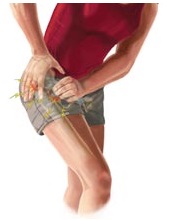
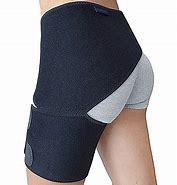
There are a million companies selling bands and compression wraps for you to wear all the time. Companies like Amazon sell them because they can, not because they help. What does Amazon know about treating injuries? Nothing. If they can sell it, they sell it, and that's it. Once one company sells some, 10 others try to knock them off and then it looks like its popular because there are a lot of them. But they don't work.
Honestly, wearing tight elastic bands around your joints all day long is a recipe for more damage to your hip. Squeezing your tendons and your ligaments and the parts of your joint so they rub against each other when you move is going to lead to damaged tendons and ligaments. Guaranteed.
Yes, compression can help squeeze the synovial fluid back into the hip joint - but only do that when you are at rest! And only do it for 15 to 30 minutes at a time. Definitely not all day long, and definitely not when you are active.
If you want support for your injury, tape it. Tape over it, not around it so your joint is getting squeezed.

Perhaps you noticed your hip pain for the first time when you were being active. You can easily mistakenly think that activity is the reason for the pain. But the reality is that most people who experience this have an injury that is the result of Isometric Strain.
Isometric strain is a fancy term that means you held your hip under pressure for a long time in one position without moving it. That leads to a bone-on-bone situation and when you make the next significant motion, your cartilage can easily get torn. That's the exact opposite of repetitive motion!
The pressure of the constant strain often damages hips but you don't realize it when it's happening. That's a significant cause of cartilage damage. Check out our Causes of Hip Busitis page for the full story.
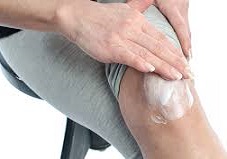
Yes, topical creams can help relieve arthritis pain. This is not because they heal arthritis, but because they just numb your nerves in the area so you don't feel it as much.
If someone is recommending topical creams to treat bursitis in your hip, then someone is more interested in making money than really helping you.
First, your cartilage is within a space called your hip capsule, or synovial capsule, and that area is sealed off from the rest of your hip. Topical creams will never get to your cartilage inside its protective capsule.
Second, with a cartilage tear, you don't want to numb your nerves. You may not enjoy the pain, but pain is your best guidance on what not to do. If you need pain relief in the moment, use cold compression. It works incredibly well. But using a numbing cream means turning off your body's defense against reinjury for hours at a time and that's just a bad idea.
Getting past hip bursitis and torn cartilage is hard enough, because it's so vulnerable to reinjury. Yes, deal with pain in the moment with cold compression. Don't turn off your body's defences with pain numbing creams.
Most people think that RICE - Rest, Ice, Compression & Elevation - is the formula to follow when treating inflammation, swelling and pain. The truth is that ice can actually freeze your skin and numb your nerves, causing 'cold burns' and even permanent damage to your underlying tissue. Rest is absolutely a good thing. The proper solution is RCCE® - Rest, Cold, Compression & Elevation.
For hip bursitis, the compression should be gentle and constant for 20 to 30 minutes at a time.
Where ice is concerned, we don't want to apply ice - we want to apply cold that is just around freezing. Yes, you want cold - and lots of it - but not so cold that it is below the freezing point of water. ColdCure® technology was developed specifically to address the need for a cold compression device that does not freeze the skin and underlying tissue. ColdCure® gel packs pose no threat of cold burns. This makes them much safer to use than other products that use ice, which can cause the skin to freeze, leading to permanent damage.
ColdCure gel packs are completely safe to use for extended treatment durations, meaning faster relief of pain and swelling. ColdCure® technology is a huge improvement on regular ice packs.
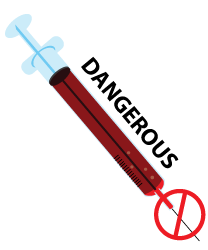
Cortisone injections are designed to temporarily relieve pain and swelling, however, they come with a variety of risks and side effects. These include skin discoloration, allergic reaction, infection, and nerve damage. They're also associated with tendon rupture.
Cortisone shots are not designed to heal the injury.
They simply mask the pain and can cause you to feel a false sense of ability, leading to a higher likelihood of re-injury.
If the cortisone shot is not administered properly, there's a chance that it won't have any effect.
Some people are also unable to metabolize cortisone, meaning it would not provide them with any relief.
Cortisone contributes to the thinning of tissue and an increase in the likelihood of a tendon rupture in your hip as a result!
Please visit our Cortisone Shots page for more information on the potential dangers of cortisone.

Surgery is not actually required in order to heal most soft tissue injuries. Injured tissue can be healed without surgery in the majority of cases. Most 'Cartilage Repair' surgeries are actually 'cartilage removal' procedures because when the piece is removed, so is the pain... for a while. Check out our Hip Bursitis Information page for the full story.
Hip surgery should be avoided as much as possible, and if you do go this route, pick your surgeon very carefully. Definitely, get more than one opinion. There are many risks and complications associated with surgery, including nerve damage, infection, tendon rupture, and more. There is also no guarantee that it will get rid of the problem for good. Most people who get 'Cartilage Repair' surgery done end up getting hip replacements years later.
If you do undergo surgery, you can still use our BFST® and ColdCure® products beforehand to help prepare your body, and after the procedure to accelerate your recovery. Always get a second opinion before signing up for hip surgery.
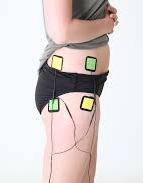
A TENS machine does not stimulate blood flow. TENS is an acronym that means Transcutaneous Electrical Nerve Stimulation. What a TENS machine is designed to do, is overstimulate the nerves to relieve pain - it deadens the nerves. While you want to reduce pain from your injury, using a TENS machine over an injury is highly not recommended.
Having your muscles pulse and flex uncontrolled will cause further tissue damage and slow down healing. It is an important part of injury recovery, to feel the pain, and respect the pain. Pain is going to tell you when you're potentially causing further damage.
TENS units are probably the most misrepresented, misused and damaging products sold. Never use TENS for anything other than to deaden nerves for conditions that cannot heal. Using TENS on soft tissue injuries including all hip issues is a recipe for disaster.
Never mask the pain heading into any activity. TENS does NOT HEAL ANY INJURY.
Check out our Treatment of Hip Injuries page for effective solutions.

The purpose of physiotherapy is to help with strengthening the muscles surrounding your injury once the healing process is underway. Starting physiotherapy before your injury has had a chance to start healing and stabilize, will only cause further damage and more pain.
After being inactive for an extended period of time, you get muscle atrophy (weakened muscles). As your injury heals, physiotherapy can be an excellent resource to help you rebuild that lost muscle.
Just remember, your physiotherapist cannot feel what you feel. If you feel pain during physio or afterwards, advocate for yourself. Physio should not hurt. You need to work within your pain limits. If an exercise hurts, you need to stop that exercise because you're not ready yet.
As you heal you will be able to do more, but do not push yourself because this will only cause re-injury. This is true throughout your entire hip recovery. Always respect the pain. Check out our Bursitis Information page for the full story.
While using a heating pad on an injury can feel good due to the warmth, they do not provide any healing benefits for your cartilage. Many sites online are marketing heating pads in place of proper treatments like BFST®.
The reality is that BFST® can heal soft tissue injuries, and heating pads can't. BFST® stimulates healthy blood flow in the area of your injury, deep inside the hip. This increase in blood flow works with the synovial fluid to speed up the healing process. Heating pads can't do this. Heating pads simply bring blood to the surface of your skin, making it hot to the touch.
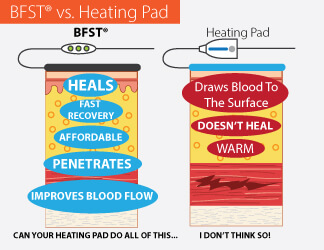
Unfortunately, many people buy inexpensive Chinese heating pads from American companies, like you see all over Amazon and the internet. The truth is, many of these people end up getting physically burned, not healed. There are hundreds of complaints filed with FDA every year from people who get skin burns, or burnt furniture, and house fires - even deaths - from defective heating pads that were sold as solutions to their injuries. And sadly, those only represent a small portion of the people actually getting hurt.
In the first 6 months of 2023, the FDA received almost 300 reports of injury and fires, just as a result of heating pads sold for healing people. These were company names you may know, like Sunbeam, Conair, Mighty Bliss, Walgreens, Softheat, CVS, Healthsmart, Dunlap, Yeamon, and Drive. Many of these were sold through Amazon. ALL of them were sold as heating pads to help people heal.
Get BFST® for healing, not heating pads. In 15 years, and with over 300,000 medical devices sold, King Brand products have had zero complaints filed with the FDA. Not one. And, BFST actually works.
BFST® technology far surpasses the heating pad in terms of therapeutic benefits. BFST wraps are 100% safe and heavily vetted by over 300,000 users and several regulatory bodies - many more than just FDA.
See our Company and Products Quality page to learn why King Brand products are so safe and so effective.
Check out our Hip Bursitis Treatment page to learn more about BFST therapy for hip injuries.
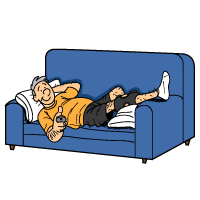
Bleeding should slow down if you raise an injury higher than your heart; however, this isn't necessary for a cartilage tear. Particularly with a mature cartilage injury, which is not usually a condition that comes with a lot of swelling.
If, though, there is a noticeable lump forming on the back of your hip as well, that's a bursa filling with synovial fluid. That synovial fluid only needs to drain from the bursa back into your hip. Synovial fluid is good stuff your body is making for your hip.
Raising your hip isn't going to move the fluid to any other area of your body, because it's not directly attached to your blood flow or affected by blood pressure. Simply resting the injured hip is sufficient.
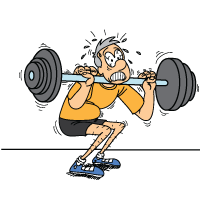
Rest is very important when recovering from an injury.
Of course, too much rest can cause weak and stiff muscles, but resting when you can will help you avoid further injury.
While it is true that moving promotes blood flow, and in turn blood flow promotes healing, too much movement too soon in the healing process is a bad thing, as it only results in re-injury and a much longer recovery time.
Exercise and Stretches do nothing to help the injury itself.
Don't misunderstand.
Motion is a very good thing.
Motion is what pumps the synovial fluid around your hip and that's important.
But 'stretching' and 'exercise' suggest pushing limits, and pushing limits puts you at high risk of reinjury.
While you're injured, only do motions and activity that don't cause you any pain or concern.
Pushing limits will not help you heal faster.
Pushing limits only risks your recovery.
Certain exercises and stretches may be beneficial to rebuild your muscles after you address the underlying injury.
But these should not be done until you are further along in the healing process.
If you are doing them too early you will know because your hip pain will start to grow again.
You need to accept that for a short while, reducing your activity is important to letting your hip get over the hump in terms of healing.
You cannot keep doing the same level of activity you were doing before becoming injured.
You need to let your hip rest.
If you are driving through the pain, you are just making your situation worse.
This can't be stressed enough about hip bursitis because your initial injury has turned into a more significant injury.
Rest is critical. Give your hip a break.
You can gradually work your way back up to your regular activities, but this will take some time.
Check out our Causes of Hip Injury page for more information on exercise and cartilage recovery.

Painkillers should never be used during times of physical activity. This is because painkillers completely block the pain signal, making you totally unaware that you're doing more damage to the injured area. Painkillers mask the pain, tricking you into thinking you're better and able to push yourself physically, when this will only result in further injury. Make sure you restrict painkillers to times when your body is at rest. Using painkillers when you're active means risking a worsening hip issue, an even longer recovery, and possibly a hip replacement in the future.
While painkillers are effective at relieving pain and inflammation, they are not designed to address the root cause. In situations where the underlying injury is osteoarthritis or tendonitis, some meds can help if used at the right times. That is not a cartilage injury though. For more information about which meds help and when, give us a call, our treatment advisors will give you some excellent free advice. You need more than painkillers, though, if you really want to heal.
Check out our Treatment of Hip Injuries page for effective ways to deal with pain.
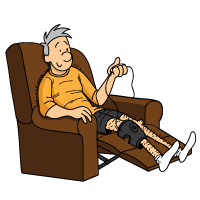
One of the biggest mistakes you can make during recovery is stopping treatment before your injury has finished healing. The healing process does not end once the pain stops. The healing process takes much longer than most people realize. (You can click here to understand how tissue heals.)
The key thing to remember is that long after the pain stops, your tissue is still healing. This means you need to continue doing BFST® treatments in order to complete the healing process. Doing regular BFST® treatments for several months after the pain is gone is extremely beneficial. Do a BFST® treatment prior to any physical activity, to warm up your circulatory system, your hip, and to help avoid re-injury.